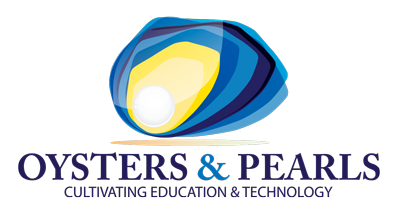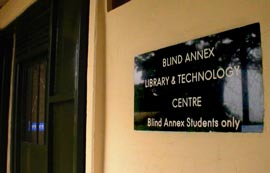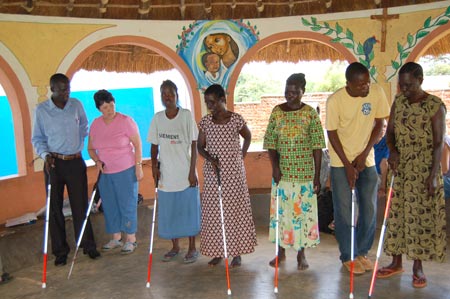Learning tools is for students who desperately need to make their lives easier and their learning more productive. The students are grateful for even the smallest gesture for, in truth, those small gestures are very large to them. If you wish to contribute, please Contact Me.
Learning Tools
Access to Textbooks & Printed Books
Access to printed materials is pretty scarce, even for the sighted students. Many students cannot afford to purchase individual copies and school libraries retain few copies of books, if at all. Few books, if any, are available in recorded, large print or Braille versions. We are taking a few steps to address this including:
- We have already stocked many copies of the much-needed books in the Blind Annex Library & Technology Center…a place where students can have friends read aloud to them. This is extremely helpful because more often than not, the sighted friend wouldn’t otherwise have access to the book either.
- We are using technology to make books accessible to the students so that the visually impaired (VI) & blind students can work independently. Often we will use a scanner to import books into a PDF or .txt format that can be “read” using JAWS and MS Word. Another technic is to export the .xtf file to a small portable device with a big price tag called a PlexTalk or Book Sense, which enables the student to playback the "book" via synthesized voice.
- Working with the Education and Special Needs Ministries and Commission to amend the contracts with publishers to provide an e-version of text books at all grade levels.
- Enabling Services of Uganda, Ltd, a private venture that provides products and services to the blind community within Uganda, has undertaken an initiative to create Braille versions of the textbooks. This is significant because it is only through Braille or Large Print reading that a student gains mastery of punctuation and grammar. Furthermore, only through Braille does the student have the ability to formulate a personal response to the text without being influenced by interpretations rendered by readers as they undertake to make those materials accessible to visually impaired students.
- Sometimes, original content for exams or study guides developed within the school can be formatted for Braille printing via Duxbury software. However this is for small projects and the software requires some mastery and used primarily by sighted persons to read Braille symbols on the screen.
- All this technology is expensive to purchase and maintain. There is little or no help outside of our philanthropy for the schools, particularly in the Northern Districts of Uganda.
- Another of our initiatives is working with Tactile Vision (Canada) to design and produce the first-ever Braille maps of Uganda so students could “feel” the borders of the country, understand the relative size of Lake Victoria in relationship to the total land size of Uganda, trace the routes of rivers and gain a geographic orientation of the cities and towns relative to each other. We have also delivered large inflatable globes with country and continent borders hand-outlined by our team in fabric paint to enable the students to trace their locations and orientations.
- Many subjects require special or modified tools such as talking calculators or graphing tools for Mathematics. Students benefit greatly from tactile models of body parts, animals, agricultural topics and many other subjects. Unfortunately, schools are not given budgets to support such acquisitions.
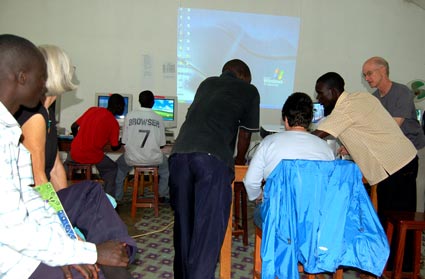
Talking Calculators with Earbuds
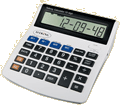
An important and useful tool for the blind and partially sighted is a talking calculator and alarm with earbuds. This special device helps students with their math studies, performing standard mathematical functions and percentages, as well as keeping them on schedule for the classes and other appointments. If they are taking any medications, the alarm will sound, letting them know when to take them. The earbud feature is critical, especially in group situations, so they listen only to their own device and not a room full of calculator or alarm clock "voices."
Talking Calculators: Talking Calculators with Earbuds at Independent Living Aids
Canes for the Blind
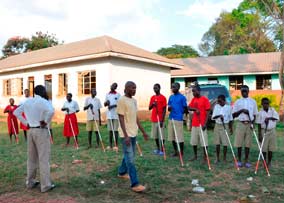
The white cane is not a magic wand, yet it wields its own kind of power. With it, a blind person can cross a busy intersection, climb a flight of stairs, or enjoy going for a walk. Canes with red luminous tips indicate that an individual has a hearing impairment in addition to a visual one. Learning to use the cane requires not only a great deal of training but determination and perseverance as well. These efforts enable a blind person to go places whenever the need arises without having to depend on a sighted guide. This freedom and independence is priceless.
Talking Watch Program
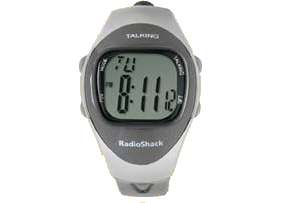
“What time is it?” A simple enough question. If you want the answer, you will glance at your cell phone (maybe you have to swipe it for the screen to come alive) or you might even be wearing a watch. How would you answer that question if you were blind? Easy. Hit the button on your talking watch. In the summer of 2012 we distributed about 40 Talking Watches to students, members of the community and student-teachers in Gulu. The price of each watch is about $20 plus tax. A small gift like this can change the life of someone.
Radio Shack’s Talking Watch
Humanware
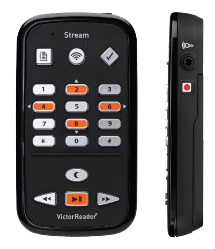
Far more than just another audio player, the new Stream’s wireless capabilities open up the world to people who are blind or visually impaired. Supports up to 32GB removable SD cards and external USB flash drives. Allows the user to read books from DAISY libraries: NLS, Bookshare, Learning Ally, and more. Also allows user to download content directly from BookshareTM and NFB-NewslineTM over wireless connection. Has a stereo microphone to record voice notes, to-do lists, classroom lectures or from a line-in device. HumanWare is available from: HumanWare.
